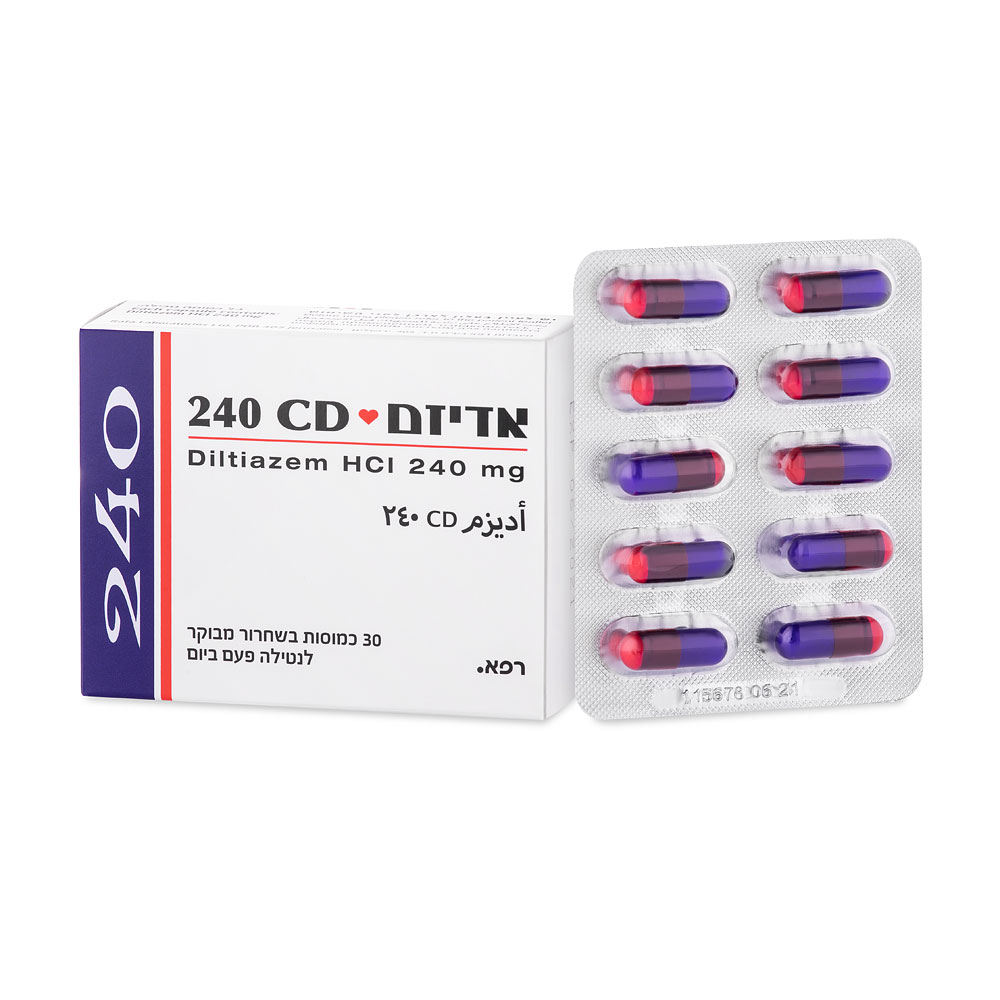Quest for the right Drug

אדיזם 240 CD ADIZEM CD 240 (DILTIAZEM HYDROCHLORIDE)
תרופה במרשם
תרופה בסל
נרקוטיקה
ציטוטוקסיקה
צורת מתן:
פומי : PER OS
צורת מינון:
קפסולות - שחרור מבוקר : CAPSULES CONTROLLED RELEASE
עלון לרופא
מינוניםPosology התוויות
Indications תופעות לוואי
Adverse reactions התוויות נגד
Contraindications אינטראקציות
Interactions מינון יתר
Overdose הריון/הנקה
Pregnancy & Lactation אוכלוסיות מיוחדות
Special populations תכונות פרמקולוגיות
Pharmacological properties מידע רוקחי
Pharmaceutical particulars אזהרת שימוש
Special Warning עלון לרופא
Physicians Leaflet
Interactions : אינטראקציות
4.5 Interaction with other medicinal products and other forms of interaction Concomitant use contraindicated: Dantrolene (infusion): Lethal ventricular fibrillation is regularly observed in animals when intravenous verapamil and dantrolene are administered concomitantly. The combination of a calcium antagonist and dantrolene is therefore potentially dangerous (see section 4.3). Lomitapide Diltiazem (a moderate CYP3A4 inhibitor) may increase lomitapide plasma concentrations through CYP3A4 inhibition leading to increased risk of elevations in liver enzymes (see section 4.3). Concomitant use requiring caution: Lithium: Risk of increase in lithium-induced neurotoxicity. Nitrate derivatives: Increased hypotensive effects and faintness (additive vasodilatating effects): In all the patients treated with calcium antagonists, the prescription of nitrate derivatives should only be carried out at gradually increasing doses. Theophylline: Increase in circulating theophylline levels. Alpha-antagonists: Increased antihypertensive effects: Concomitant treatment with alpha-antagonists may produce or aggravate hypotension. The combination of diltiazem with an alpha-antagonist should be considered only with the strict monitoring of the blood pressure. Amiodarone, digoxin: Increased risk of bradycardia: Caution is required when these are combined with diltiazem, particularly in elderly subjects and when high doses are used. Diltiazem hydrochloride may cause small increases in plasma levels of digoxin, requiring careful monitoring of AV conduction. Beta-blockers: Possibility of rhythm disturbances (pronounced bradycardia, sinus arrest), sino-atrial and atrio-ventricular conduction disturbances and heart failure (synergistic effect). Patients with pre-existing conduction defects should not receive the combination of diltiazem and beta-blockers. Such a combination must only be used under close clinical and ECG monitoring, particularly at the beginning of treatment. Other antihypertensive drugs: Enhanced antihypertensive effect may occur with concomitant use of other antihypertensive drugs (e.g. beta-blockers, diuretics, ACE- inhibitors) or drugs that cause hypotension such as aldesleukin and antipsychotics. Other antiarrhythmic agents: Since diltiazem has antiarrhythmic properties, its concomitant prescription with other antiarrhythmic agents is not recommended (additive risk of increased cardiac adverse effects). This combination should only be used under close clinical and ECG monitoring. Carbamazepine: Increase in circulating carbamazepine levels: It is recommended that the plasma carbamazepine concentrations be assayed and that the dose should be adjusted if necessary. Rifampicin: Risk of decrease of diltiazem plasma levels after initiating therapy with rifampicin: The patient should be carefully monitored when initiating or discontinuing rifampicin treatment. Anti-H2 agents (cimetidine, ranitidine): Increase in plasma diltiazem concentrations. Patients currently receiving diltiazem therapy should be carefully monitored when initiating or discontinuing therapy with anti-H2 agents. An adjustment in diltiazem daily dose may be necessary. Protease inhibitors (atazanavir, ritonavir): Increase in plasma diltiazem concentrations. Ciclosporin: Increase in circulating ciclosporin levels: It is recommended that the ciclosporin dose be reduced, renal function be monitored, circulating cyclosporin levels be assayed and that the dose should be adjusted during combined therapy and after its discontinuation. General information to be taken into account: Due to the potential for additive effects, caution and careful titration are necessary in patients receiving diltiazem concomitantly with other agents known to affect cardiac contractility and/or conduction. Diltiazem is metabolised by CYP3A4. A moderate (less than 2-fold) increase of diltiazem plasma concentration in cases of co-administration with a stronger CYP3A4 inhibitor has been documented. Diltiazem is also a CYP3A4 isoform inhibitor. Co-administration with other CYP3A4 substrates may result in an increase in plasma concentration of either co-administered drug (e.g. cilostazol, ivabradine, sirolimus, tacrolimus). Care should be exercised in patients taking these drugs. Concomitant use of diltiazem with cilostazol and ivabradine should be avoided. Co-administration of diltiazem with a CYP3A4 inducer may result in a decrease of diltiazem plasma concentrations. Barbiturates (phenobarbital, primidone): serum levels of diltiazem may be decreased by concomitant usage of CYP3A4 inducers. Phenytoin: serum levels of diltiazem may be decreased by concomitant usage of CYP3A4 inducers. Diltiazem may increase serum levels of phenytoin. Benzodiazepines (midazolam): Diltiazem significantly increases plasma concentrations of midazolam and prolongs its half-life. Special care should be taken when prescribing short-acting benzodiazepines metabolised by the CYP3A4 pathway in patients using diltiazem. Diltiazem may increase bioavailability of tricyclic antidepressants. Corticosteroids (methylprednisolone): Inhibition of methylprednisolone metabolism (CYP3A4) and inhibition of P-glycoprotein: The patient should be monitored when initiating methylprednisolone treatment. An adjustment in the dose of methylprednisolone may be necessary. Statins (simvastatin, atorvastatin): Diltiazem is an inhibitor of CYP3A4 and has been shown to significantly increase the AUC of some statins. The risk of myopathy and rhabdomyolysis due to statins metabolised by CYP3A4 may be increased with concomitant use of diltiazem. When possible, a non CYP3A4-metabolised statin should be used together with diltiazem, otherwise close monitoring for signs and symptoms of a potential statin toxicity is required. ADIZEM CD® capsules should not be taken at the same time as alcohol, as it may increase the rate of release of diltiazem from the controlled release preparation. In addition the combination of alcohol and diltiazem may have an additive vasodilatory effect.

מסגרת הכללה בסל
התוויות הכלולות במסגרת הסל
| התוויה | תאריך הכללה | תחום קליני | Class Effect | מצב מחלה |
|---|---|---|---|---|
| לב וכלי דם | AMLODIPINE, FELODIPINE, DILTIAZEM, LERCANIDIPINE |
שימוש לפי פנקס קופ''ח כללית 1994
לא צוין
תאריך הכללה מקורי בסל
01/01/2000
הגבלות
תרופה מוגבלת לרישום ע'י רופא מומחה או הגבלה אחרת
מידע נוסף
